| Listing 1 - 8 of 8 |
Sort by
|
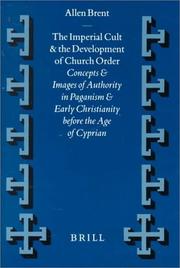
ISSN: 0920623X ISBN: 9004114203 9004313125 9789004114203 9789004313125 Year: 1999 Volume: 45 Publisher: Leiden ; Boston : Brill,
Abstract | Keywords | Export | Availability | Bookmark
 Loading...
Loading...Choose an application
- Reference Manager
- EndNote
- RefWorks (Direct export to RefWorks)
Recent studies have re-assessed Emperor worship as a genuinely religious response to the metaphysics of social order. Brent argues that Augustus' revolution represented a genuinely religious reformation of Republican religion that had failed in its metaphysical objectives. Against this backcloth, Luke, John the Seer, Clement, Ignatius and the Apologists refashioned Christian theology as an alternative answer to that metaphysical failure. Callistus and Pseudo-Hippolytus gave different responses to Severan images of imperial power. The early, Monarchian theology of the Trinity was thus to become a reflection of imperial culture and its justification that was later to be articulated both in Neo-Platonism, and in Cyprian's view of episcopal Order. Contra-cultural theory is employed as a sociological model to examine the interaction between developing Pagan and Christian social order.
Church polity --- Emperor worship --- Christianity and other religions --- Eglise --- Culte impérial --- Christianisme --- History --- Roman. --- Gouvernement --- Histoire --- Relations --- Religion romaine --- Roman --- 27 <37> --- -Church polity --- -Emperor worship --- -Emperors --- Worship, Emperor --- Apotheosis --- Cults --- Kings and rulers --- Christian sects --- Christianity --- Church government --- Ecclesiastical polity --- Polity, Ecclesiastical --- Church --- Polity (Religion) --- Syncretism (Christianity) --- Religions --- Kerkgeschiedenis--Rome. Oud-Italië --- -Cult --- Religious aspects --- Government --- Polity --- -Kerkgeschiedenis--Rome. Oud-Italië --- -27 <37> --- Culte impérial --- Emperor worship, Roman --- Primitive and early church, ca. 30-600 A.D. --- Rome --- Christianity. --- Church polity. --- Emperor worship. --- Interfaith relations. --- Romans --- Emperors --- Church history --- Religion. --- Cult --- Rome (Empire) --- Rim --- Roman Empire --- Roman Republic --- Romi (Empire) --- Byzantine Empire --- Italy --- Church polity - History - Early church, ca 30-600 --- Emperor worship - Rome --- Christianity and other religions - Roman
Book
ISBN: 2283601754 9782283601754 Year: 1999 Publisher: Paris Lethielleux
Abstract | Keywords | Export | Availability | Bookmark
 Loading...
Loading...Choose an application
- Reference Manager
- EndNote
- RefWorks (Direct export to RefWorks)
Indulgences --- Church discipline --- 248.158.1 --- Aflaten --- 248.158.1 Aflaten --- Jubilee indulgences --- Discipline, Church --- Discipline, Ecclesiastical --- Ecclesiastical discipline --- Church polity --- Discipline
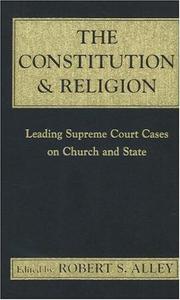
ISBN: 1573927031 Year: 1999 Publisher: New York (N.Y.): Prometheus
Abstract | Keywords | Export | Availability | Bookmark
 Loading...
Loading...Choose an application
- Reference Manager
- EndNote
- RefWorks (Direct export to RefWorks)
#KVHA:Grondwet; Verenigde Staten --- #KVHA:Recht; Verenigde Staten --- #KVHA:Godsdienst; Verenigde Staten --- #KVHA:American Studies --- Church and state --- Ecclesiastical law --- Church law --- Law, Ecclesiastical --- Church polity --- Religious law and legislation --- Theology, Practical --- Canon law
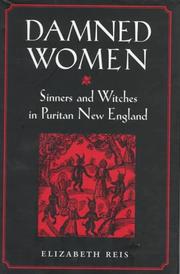
ISBN: 1501713337 1501713345 9781501713347 0801428343 9780801428340 0801486114 9780801486111 9781501713330 Year: 1999 Publisher: Ithaca, NY
Abstract | Keywords | Export | Availability | Bookmark
 Loading...
Loading...Choose an application
- Reference Manager
- EndNote
- RefWorks (Direct export to RefWorks)
In her analysis of the cultural construction of gender in early America, Elizabeth Reis explores the intersection of Puritan theology, Puritan evaluations of womanhood, and the Salem witchcraft episodes. She finds in those intersections the basis for understanding why women were accused of witchcraft more often than men, why they confessed more often, and why they frequently accused other women of being witches. In negotiating their beliefs about the devil's powers, both women and men embedded womanhood in the discourse of depravity.Puritan ministers insisted that women and men were equal in the sight of God, with both sexes equally capable of cleaving to Christ or to the devil. Nevertheless, Reis explains, womanhood and evil were inextricably linked in the minds and hearts of seventeenth-century New England Puritans. Women and men feared hell equally but Puritan culture encouraged women to believe it was their vile natures that would take them there rather than the particular sins they might have committed.Following the Salem witchcraft trials, Reis argues, Puritans' understanding of sin and the devil changed. Ministers and laity conceived of a Satan who tempted sinners and presided physically over hell, rather than one who possessed souls in the living world. Women and men became increasingly confident of their redemption, although women more than men continued to imagine themselves as essentially corrupt, even after the Great Awakening.
Witchcraft --- Puritans --- Women --- Black art (Witchcraft) --- Sorcery --- Occultism --- Wicca --- Precisians --- Church polity --- Congregationalism --- Puritan movements --- Calvinism --- Human females --- Wimmin --- Woman --- Womon --- Womyn --- Females --- Human beings --- Femininity --- History --- History. --- Religious life --- Social conditions. --- New England --- 17th century --- Social conditions
Book
ISBN: 3631351836 9783631351833 Year: 1999 Volume: 5 Publisher: Frankfurt am Main Lang
Abstract | Keywords | Export | Availability | Bookmark
 Loading...
Loading...Choose an application
- Reference Manager
- EndNote
- RefWorks (Direct export to RefWorks)
Patriarchs and patriarchate (Catholic Oriental) --- Iconoclasm --- Patriarches et patriarcat catholiques orientaux --- Iconoclasme --- Germanus --- Catholic Church --- Orthodox Eastern Church --- Eglise catholique --- Eglise orthodoxe --- Byzantine rite --- Clergy --- Rite byzantin --- Clergé --- Byzantine Empire --- Empire byzantin --- Church history --- History --- Histoire religieuse --- Histoire --- Patriarchs and patriarchate --- Constantinople (Ecumenical patriarchate) --- 281.5 --- -Patriarchs and patriarchate --- -Church polity --- Idols and images --- Oosterse, Byzantijnse kerken:--in het algemeen --- Early works to 1800 --- Worship --- -Constantinople (Ecumenical patriarchate) --- -Church history --- -Oosterse, Byzantijnse kerken:--in het algemeen --- 281.5 Oosterse, Byzantijnse kerken:--in het algemeen --- -Iconoclasm --- Clergé --- Church polity --- Цареградская патриархия --- T︠S︡aregradskai︠a︡ patriarkhii︠a︡ --- Oikoumenikon Patriarcheion --- Vselenskai︠a︡ Patriarkhii︠a︡ --- Ökumenisches Patriarchat --- Constantinople (Patriarchate) --- Patriarchat von Konstantinopel --- Patriarcheion Kōnstantinoupoleos --- Megalē Ekklēsia tēs Kōnstantinoupōleōs --- Great Church of Constantinople --- Patriarcat œcuménique --- Ecumenical Patriarchate --- Œcumenical Patriarchate --- History. --- Church history. --- Clergy. --- Iconoclasm - Byzantine Empire - History --- Patriarchs and patriarchate - Byzantine Empire - History --- Constantinople (Ecumenical patriarchate) - History --- Byzantine Empire - Church history --- T︠S︡arigradska patriarshii︠a︡ --- Цариградска патриаршия
Book
ISBN: 3727812516 9783727812514 Year: 1999 Volume: 7 Publisher: Freiburg Universitätsverl.
Abstract | Keywords | Export | Availability | Bookmark
 Loading...
Loading...Choose an application
- Reference Manager
- EndNote
- RefWorks (Direct export to RefWorks)
Ecclesiastical law --- Church and state --- 348 --- -Ecclesiastical law --- -Church law --- Law, Ecclesiastical --- Church polity --- Religious law and legislation --- Theology, Practical --- Canon law --- Christianity and state --- Separation of church and state --- State and church --- State, The --- Kerkelijk recht. Canoniek recht --- -Kerkelijk recht. Canoniek recht --- 348 Kerkelijk recht. Canoniek recht --- -348 Kerkelijk recht. Canoniek recht --- Church law --- 348 Ecclesiastical law. Canon law. Religious law --- Ecclesiastical law. Canon law. Religious law --- Ecclesiastical law - Switzerland. --- Church and state - Switzerland.
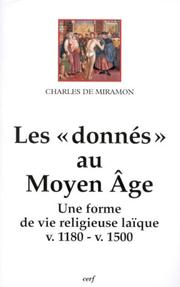
ISBN: 2204061018 9782204061018 Year: 1999 Publisher: Paris Cerf
Abstract | Keywords | Export | Availability | Bookmark
 Loading...
Loading...Choose an application
- Reference Manager
- EndNote
- RefWorks (Direct export to RefWorks)
Christian church history --- anno 1200-1799 --- anno 1100-1199 --- Laity --- Christian life --- Spiritual life --- Church history --- Laïcat --- Vie chrétienne --- Vie spirituelle --- Eglise --- Catholic Church --- History --- Eglise catholique --- Histoire --- Monasticism and religious orders --- 27 "04/14" --- -Monasticism and religious orders --- -Monachism --- Monastic orders --- Monasticism and religious orders for men --- Monasticism and religious orders of men --- Orders, Monastic --- Religious orders --- Brotherhoods --- Christian communities --- Brothers (Religious) --- Friars --- Monks --- Superiors, Religious --- Christian laity --- Laymen --- Church polity --- Lay ministry --- Kerkgeschiedenis--Middeleeuwen --- -History --- -Laity --- -Kerkgeschiedenis--Middeleeuwen --- -27 "04/14" --- -Christian church history --- Laïcat --- Vie chrétienne --- -Christian laity --- Monachism --- Orders, Religious --- Monasticism and religious orders - History - Middle Ages, 600-1500. --- Laity - Catholic Church - History - To 1500. --- EUROPE --- EGLISE CATHOLIQUE --- VIE RELIGIEUSE --- MOYEN AGE --- HISTOIRE --- 0600-1500 (MOYEN AGE)
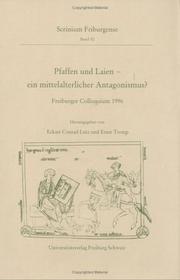
ISBN: 3727811307 Year: 1999
Abstract | Keywords | Export | Availability | Bookmark
 Loading...
Loading...Choose an application
- Reference Manager
- EndNote
- RefWorks (Direct export to RefWorks)
262 --- Church history --- -Laity --- -262 Kerkelijk bestuur. Kerkelijke organisatie. Kerkelijke instellingen --- Kerkelijk bestuur. Kerkelijke organisatie. Kerkelijke instellingen --- Christianity --- Ecclesiastical history --- History, Church --- History, Ecclesiastical --- History --- Christian laity --- Laymen --- Church polity --- Lay ministry --- Catholic Church --- -Clergy --- Laity --- 262 Kerkelijk bestuur. Kerkelijke organisatie. Kerkelijke instellingen --- Clergy --- Church of Rome --- Roman Catholic Church --- Katholische Kirche --- Katolyt︠s︡ʹka t︠s︡erkva --- Römisch-Katholische Kirche --- Römische Kirche --- Ecclesia Catholica --- Eglise catholique --- Eglise catholique-romaine --- Katolicheskai︠a︡ t︠s︡erkovʹ --- Chiesa cattolica --- Iglesia Católica --- Kościół Katolicki --- Katolicki Kościół --- Kościół Rzymskokatolicki --- Nihon Katorikku Kyōkai --- Katholikē Ekklēsia --- Gereja Katolik --- Kenesiyah ha-Ḳatolit --- Kanisa Katoliki --- כנסיה הקתולית --- כנסייה הקתולית --- 가톨릭교 --- 천주교
| Listing 1 - 8 of 8 |
Sort by
|

 Search
Search Feedback
Feedback About UniCat
About UniCat  Help
Help News
News